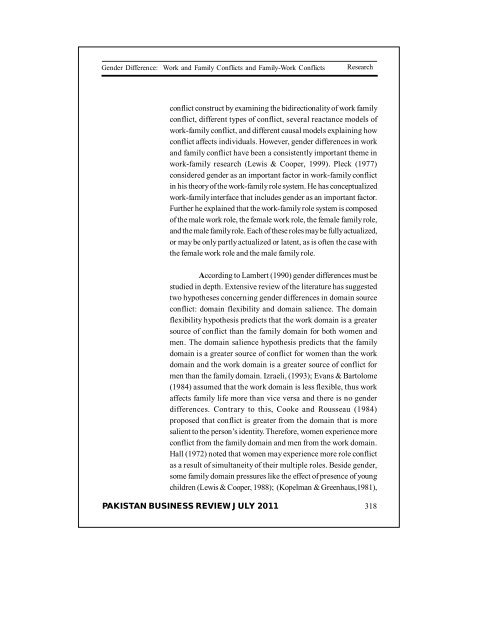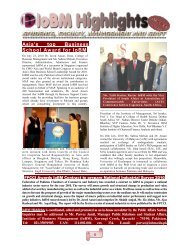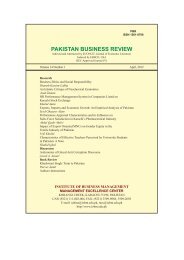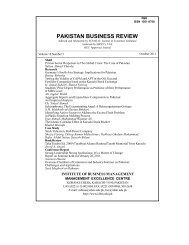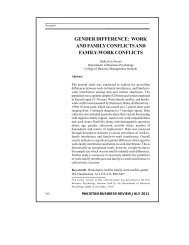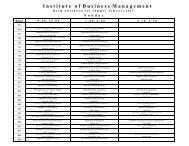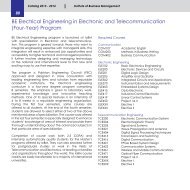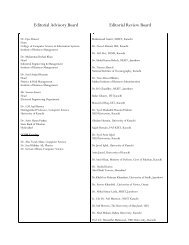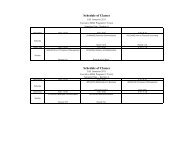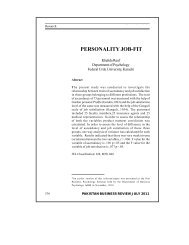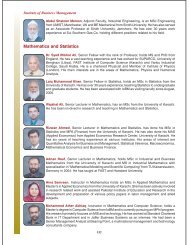PAKISTAN BUSINESS REVIEW - Institute of Business Management
PAKISTAN BUSINESS REVIEW - Institute of Business Management
PAKISTAN BUSINESS REVIEW - Institute of Business Management
Create successful ePaper yourself
Turn your PDF publications into a flip-book with our unique Google optimized e-Paper software.
Gender Difference: Work and Family Conflicts and Family-Work Conflicts<br />
Research<br />
conflict construct by examining the bidirectionality <strong>of</strong> work family<br />
conflict, different types <strong>of</strong> conflict, several reactance models <strong>of</strong><br />
work-family conflict, and different causal models explaining how<br />
conflict affects individuals. However, gender differences in work<br />
and family conflict have been a consistently important theme in<br />
work-family research (Lewis & Cooper, 1999). Pleck (1977)<br />
considered gender as an important factor in work-family conflict<br />
in his theory <strong>of</strong> the work-family role system. He has conceptualized<br />
work-family interface that includes gender as an important factor.<br />
Further he explained that the work-family role system is composed<br />
<strong>of</strong> the male work role, the female work role, the female family role,<br />
and the male family role. Each <strong>of</strong> these roles may be fully actualized,<br />
or may be only partly actualized or latent, as is <strong>of</strong>ten the case with<br />
the female work role and the male family role.<br />
According to Lambert (1990) gender differences must be<br />
studied in depth. Extensive review <strong>of</strong> the literature has suggested<br />
two hypotheses concerning gender differences in domain source<br />
conflict: domain flexibility and domain salience. The domain<br />
flexibility hypothesis predicts that the work domain is a greater<br />
source <strong>of</strong> conflict than the family domain for both women and<br />
men. The domain salience hypothesis predicts that the family<br />
domain is a greater source <strong>of</strong> conflict for women than the work<br />
domain and the work domain is a greater source <strong>of</strong> conflict for<br />
men than the family domain. Izraeli, (1993); Evans & Bartolome<br />
(1984) assumed that the work domain is less flexible, thus work<br />
affects family life more than vice versa and there is no gender<br />
differences. Contrary to this, Cooke and Rousseau (1984)<br />
proposed that conflict is greater from the domain that is more<br />
salient to the person’s identity. Therefore, women experience more<br />
conflict from the family domain and men from the work domain.<br />
Hall (1972) noted that women may experience more role conflict<br />
as a result <strong>of</strong> simultaneity <strong>of</strong> their multiple roles. Beside gender,<br />
some family domain pressures like the effect <strong>of</strong> presence <strong>of</strong> young<br />
children (Lewis & Cooper, 1988); (Kopelman & Greenhaus,1981),<br />
<strong>PAKISTAN</strong> <strong>BUSINESS</strong> <strong>REVIEW</strong> JULY 2011<br />
318


